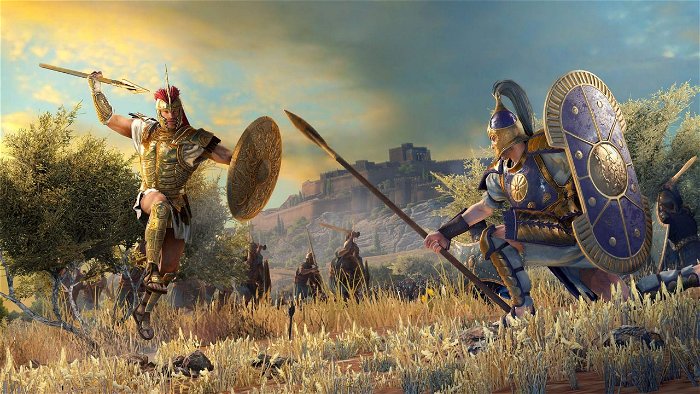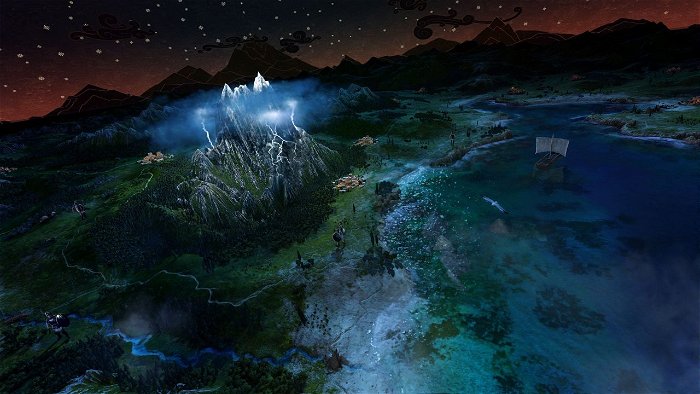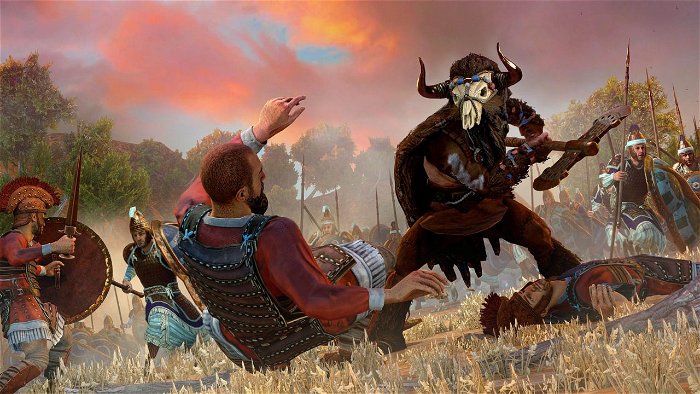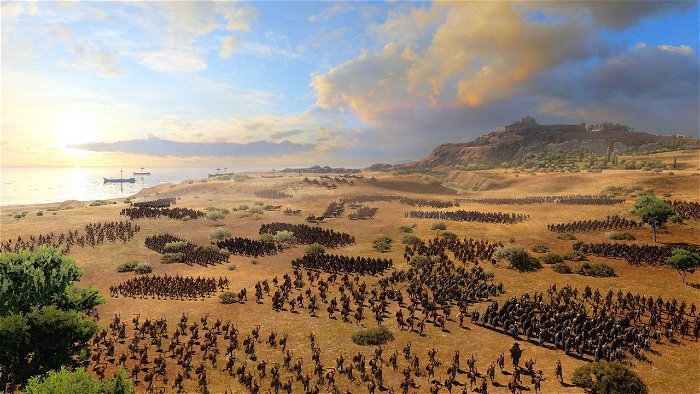Continuing their legacy of expansive and epic ventures into historical warfare, Creative Assembly and Sega today announced a brand-new member of the franchise that will have players shouting “Immortality? Take it. It’s yours!”: Total War: Troy.
Taking players back to the Bronze age at the time of the ancient Myceneans — the furthest back in time the series has ever travelled — Total War: Troy mixes myth with reality, drawing inspiration from Greek mythology and Homers Illiad. The team at Creative Assembly have worked tirelessly to infuse as much research as they were able to obtain in the game, with historically accurate maps of ancient Greece, Troy, and surrounding the Agean Sea, units, and combat, while blending in mythological Greek heroes, gods and creatures to create a fresh and dynamic experience to the franchise that Total War fans have come to love.

The initial campaign takes place after Paris unites with Helen of Troy and is set in a gorgeous world that blends realistic visuals with a stunning two-dimensional ancient Greek art style, and is led through the narrative by the melodiously interpreted voice of Homer. Players take control of one of eight factions — four Greek and four Trojan — as they embark on strategic battles to build legendary acclaim and create their own myths.
Total War: Troy introduces a number of new features to the franchise, including heroes who’s mood affects the outcome of battles, a completely unique take on calvary units, and the ability for certain unites to switch between attack and defensive stances, as well as the largest map out of any of the Total War games. Players will see legendary historical and mythological figures such as Achilles, Hector, Iris — each with their own personality traits which, depending on their mood, can affect their armies performance in battle.
As one would hope from a game that relies so heavily on mythology, the gods of Mount Olympus play a prominent role in Total War: Troy. Earning the favour of various gods, including Poseidon, Apollo, Ares, Hera, Athena, and of course, Zeus, will provide unique benefits to armies which could drastically affect the outcome of each battle.
While at Gamescom, CGMagazine had the opportunity to talk with Todor Nikolov, Lead Designer on Total War: Troy to find out a little more about what players can expect from this new installment to the Total War series.

CGM: To start, I’d like to know more about how you’re mixing in myth and history together to give it a more dynamic interpretation.
Todor Nikolov: Yeah. Basically, when we started developing the game, we did our research, and our research showed that there is a number of historical records — a number of archaeological finds that we can use, and we have used them. Because we have a relatively good idea of how for example, unit armaments appeared. Where were the cities that people live in, how they looked, etc? We use the literature in the Illiad and the rest of the Trojan War-related materials in order to breathe life into this sort of dry field of archaeological finds because one of the problems we have, for example, is that we don’t know the names of the ancient Mycenaean kings. When you put Agamemnon in there and Agamemnon comes with his own character as a power-hungry ruler, it becomes much easier. And this is what the game became. It’s history imbued with literature and myth.
CGM: During the presentation, we’ve talked about some of the hero characters that you’re using as part of the major campaigns. How did you tie in history and myth in coming up with attacks and special, special features for each of these heroes?
TN: Well, for example, we’re often trying to portray the character of a hero as it is in the Illiad through his faction mechanics. Achillies got mentioned in the presentation. He’s got two faction mechanics, one of them is related to the fact that in the Illiad he’s described as being governed by his emotions — his all-powerful rage, which you know spelled doom for many. So this is one of his faction mechanics. He can assume different moods, and the player gets to control that.
For example, Achillies is always proud, which gives him no special bonuses; no negatives. But he can become enraged, which makes him and his troops more powerful in combat, however, his economy suffers. He can also get insulted and depressed, and every one of these states carries gameplay bonuses and negatives. So, you have to decide when you play as Achillies: right now, you’re going to wage war, for example. So you will need an enraged Achillies — what do you do to achieve that?
His other mechanic is related to the fact that he only strives to be the best, the perfect warrior. So as he walks around the land in the game, he encounters new heroes, and he compares himself to them, and he tries to prove that he’s best. He can either challenge them into open battle, which will inevitably cause a war between him and the other faction, or he can challenge them to an off-screen duel, and Achillies becomes unavailable for a couple of turns. And he always defeats the character he’s fighting. He then ascends a rank in this “Hall of Fame” that only he adheres to, basically,

CGM: That’s like his own personal glory system, right?.
TN: Yeah, it’s sort of a glorious system. Achillies always strives to be at the top, because only when he is at the very top of the chain of heroes, he receives bonuses related to his characters who become more loyal. The influence of this tribe grows, and also his armies, which become more efficient than battle. Depending on the outcomes of those strange challenges, the moods of Achillies are also affected, because he challenges the hero, they fight somewhere off-screen, but if the opposing hero was disrespectful towards Achillies, Achillies might become insulted. And, in turn, this will affect his diplomacy and tonnes of other things. And this is the way in which we have tried to represent the characters in the game, along with the story.
CGM: About how many of the heroes found in the Illiad and beyond will be in the game by launch?
TN: Currently we’ve built eight heroes — four of them are on the Greek side, and the other ones are Trojans, the founders of the city.
CGM: We will also see special mythological characters such as the Minotaur introduced in Total War: Troy. Could you give us a little overview of them and how they contribute to a player’s armies and battle outcomes?
TN: Well, for example, the Minotaur that you saw [in the Gamescom presentation] resembles a hero character, because he’s a single entity unit. He is big and powerful and has a couple of events that are available only to him. His strength can be compared to a level hero. So he’s more of a mid- to late-game unit, and it gives him an edge in combat.
But there are other types of mythological related entities in the game. Some of those are actually not single entities, but their whole units. For example, we’ve got a lack of cavalry units, because this was the Bronze Age and heavy calvary was not acceptable back then because people use chariots. So we have introduced to the game units of centaurs to the game — they’re basically horsemen. We have put them on the map in places which are mythological related to where centaurs live. If you manage to come to those regions and build certain buildings over there, you are able to recruit centaurs. They are unique in the game because there are horsemen, and at that time, armies wouldn’t expect that. Nobody would expect cavalry charges at that time, like heavily armoured Knights just smashing into enemy units. Now there’s a cavalry that is used to flank and harass and chase down stragglers. But they’re also the centaurs.

CGM: Will we see historically accurate battle formations and defensive formations used in Total War: Troy?
TN: Yeah. Well, we haven’t put much emphasis on different battle formations, because, to be honest, we’re not sure that there was any sort of information. We have to keep it true to the way Total War is played. So basically, you will see your units arranged in rows, some of the units will have slightly staggered formation. So it would be easier to flank them and drag them which affects your moral penalty.
We have introduced a new ability for some units, the ability to switch weapons. So for example, you get certain Spearman units, which are very tough and have a high defence. At certain times they can store their shields on their backs and they can grip the spear with both hands, and suddenly, they become very capable charges. So we have introduced that ability to quickly switch between an offensive and defensive position for a unit
CGM: And will that affect all the units across the board?
TN: Just certain units.
CGM: Based on the preview screens shown, it looks as if Total War: Troy‘s art style is a blend between realistic visuals and classical two-dimensional greek art style. What was the reason behind this choice?
TN: Initially we considered having the art style made according to the art of ancient Mycenaeans, but [that particular art style] is very — how shall I put it — rather rudimentary. And we decided that if we are to be true to the whole truth behind the myth thing, the whole game can be separated into the following layers: we get the truth when you see the campaign map, when you see the landmarks, the cities, the characters moving down there, the water, which is very pretty. Also, the units as they move around the battlefield, and the way their weapons and their armour, etc, look. All of this forms the truth layer.
Above that is the myth layer. We were inspired by the art of ancient Greeks who came after the Trojan War, and this art of theirs is how they imagined the Total War would be. So for example, when you play the game, and an event pops up about Achilles, and you get a picture of Achillies which is inspired by this Greek pottery style, you won’t see Achilles exactly as he is in the game, but the way the ancient Greeks might have imagined.
CGM: Let’s talk a little bit about earning the favour of the gods. Could you explain how that mechanic works and why you decided to go that direction, instead of making the gods themselves a special playable character?
TN: Well, it’s related to how the gods are portrayed in the Illiad. As you read the Illiad, apparently the gods are characters, but if you think over it, are they real, or are they something that people imagine? Because whenever a god is talking to a hero, only the hero can hear the god. And whenever the god appears, it assumes the shape of a character. So Athena might speak to all the Greeks, but she will speak assuming the shape of a certain arrow, for example. So they’re not, you know, material beings, apparently.
We decided to go down that way, where the representations of the gods in the game is based on this favour system, where you have to gain the favor of certain gods in order to enjoy bonuses. If some Gods do not like you and have, you have less their favor, you get negatives. And the whole thing is about balancing the favor of the gods, so that you gain the bonuses that you want, related to your play style, and avoid the negatives that would affect your playstyle negatively.
For example, Poseidon is the God of the sea. So if Poseidon hates you, obviously, you will get more attrition and you will lose man if travel across the sea. But if you do not need to cross the sea, at a certain point — if you decided to play the game avoiding the sea (although it’s there) you might, you might actually not care about Poseidon that much.
Most of the things that you do, as an ordinary player, like winning battles, and conquering the land, will affect the favor of different gods. You can also do specific things to specific gods in order to gain that favour. You can make sacrifices, you can pray to the gods. You’ve got these priestess agents, which are related to the gods’ favour system that can perform rituals at settlements. They can not only increase your favour but reduce the favor of other factions because a loss of favor effects not only the player but every other faction in the game. So for example, if Iris favors you, your warriors are stronger. If you fight against someone who is not favored by Iris but hated by Iris, you will most likely stop them, because it’s always good to have a god of war on your side.

CGM: I understand that sea warfare was prominent during this period, are we going to see some very specific troops and campaigns where we can actually do a lot of sea battles?
TN: Well, it’s an interesting challenge that we had in the beginning, because we did our research on possible naval combat in the Bronze Age, and it seemed to be underwhelming to be portrayed in proper terms. But we received the solution to this problem via the Vampire Coast DLC of Total War: Warhammer 2 where there were these naval battles, where two armies would meet at sea, and then a land battle with commands on a convenient nearby island would take place. And luckily, we are in the Agean. So when two naval armies meet in the middle of the sea, they will find the nearby island and they will fight on it. And it will have every kind of feature that is battle-related. Most naval battles on the island will be affected by the favor of Poseidon more than the favor of Iris, for example.
So yeah, that’s our way to try things.
CGM: So you’re trying to bring as much historical accuracy to the game as possible.
TN: Yeah, indeed. And really, it would a bit underwhelming to properly portray a Bronze Age battle, because we really have no idea how it might have been. Yeah. There wasn’t a lot of surviving information.




